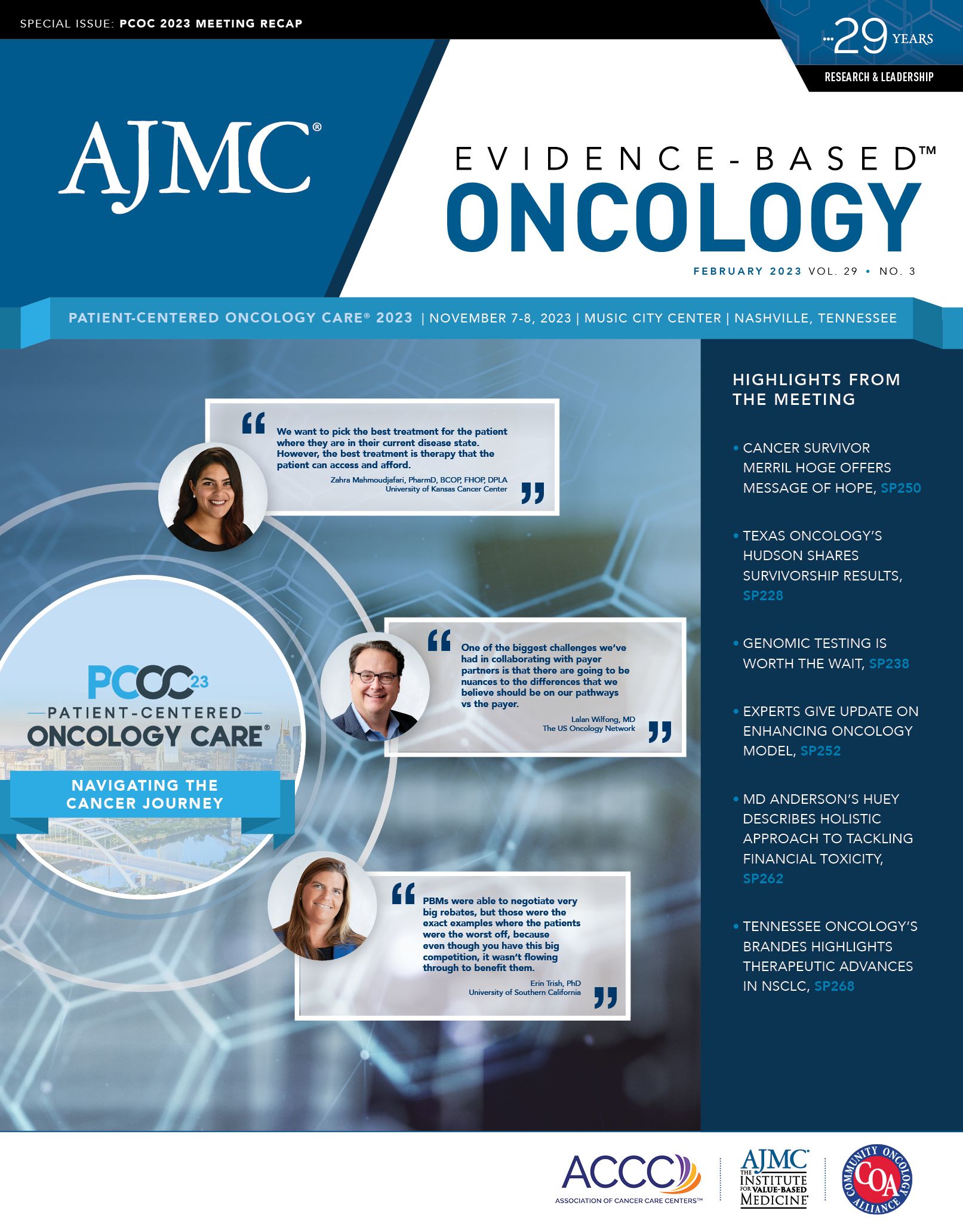News
Article
Evidence-Based Oncology
PBMs: When Competition Does Not Benefit Consumers
Author(s):
Coverage from "Navigating the PBM Landscape: How a Heath Care Economist Sees It," at Patient-Centered Oncology Care 2023.
In recent years, the practices of pharmacy benefit managers (PBMs), initially formed to foster competition in the pharmaceutical market and help control drug costs, have been recognized instead as drivers of drug prices in the United States. The issue has even piqued the interest of the US House Committee on Oversight and Accountability, which held a hearing in October 2023 to highlight self-benefiting, anticompetitive, and opaque practices that providers have been flagging for years.1
Erin Trish, PhD | Image: USC photo

Stephen Schleicher, MD, MBA | Image: Tennessee Oncology

In a session held during the 2023 Patient-Centered Oncology Care meeting, Erin Trish, PhD, codirector of the USC Schaeffer Center and associate professor of pharmaceutical and health economics, University of Southern California in Los Angeles, fielded questions about the PBM landscape from Stephen Schleicher, MD, MBA, chief medical officer at Tennessee Oncology. The discussion, titled “Fireside Chat: Navigating the PBM Landscape: How a Heath Care Economist Sees It,” provided a fresh perspective on the topic for an audience of oncology stakeholders.
Trish joined the USC Schaeffer Center roughly 10 years ago and at that time, she said, the Fair Trade Commission (FTC) was investigating various transactions and mergers in the PBM space.
“There was this very one-sided focus,” Trish said. “The FTC was coming from a place of, ‘We’re worried about drug prices, and we want some sort of entity to combat the drug pricing power of drug manufacturers, and so we’re going to kind of stand behind these PBMs as they get bigger and allow these transactions to go through.’ And in contrast to the insurance market world, nobody, in my opinion, in any of the antitrust agencies, was really asking questions about what impact that was going to have on the patients and the providers.”
The economics are complicated, she said, and that is what spurred her interest in the topic. Schleicher also pointed out the various calls to action from the oncology space and the horror stories often shared by oncologists, including in the Community Oncology Alliance’s series on the topic.2
“A lot of us have felt the PBM pains for a while now,” Schleicher said. “Do you think cancer kind of felt it first, and that’s why people have been kind of overlooking this, or how is cancer different to some other aspects of medicine, where PBM plays such a big role for us?”
Trish discussed a few factors that play into the impact PBMs have on the oncology space compared with other care settings. In oncology, drug prices are already notoriously high, making issues related to the current dynamics of the PBM space more effective than they might be in other specialties. One example is out-of-pocket costs for patients, which have been shown to produce significant financial toxicity and serve as barriers to care for many.
PBM practices such as prior authorization and other utilization management practices can also affect the patient-oncologist relationship, which Trish said came into focus when she was invited to testify before Congress alongside Debra Patt, MD, PhD, MBA, executive vice president at Texas Oncology. During her testimony, Patt highlighted the effects of prior authorization and the delays in care it can cause.3
Another issue is that treatment with oncology drugs is complex, with heterogeneity both in cancer cases and in how patients react to drugs. An intermediary stepping into the clinical setting may have potential to create more of a problem in this setting than in conditions where treatment is not as complicated.
PBMs are also contributing to spread pricing, Schleicher said, posing the question of how they fit into the picture.
Drug prices have been a topic of interest in research at the Schaeffer Center for years, Trish said, but a major barrier to gaining a full understanding of who is responsible for it has been the lack of transparency in the market. There is a lack of data on transaction prices throughout the distribution system, making it difficult to unpack the issue of drug prices.
“As we got into it, we realized that it was a very complicated system,” Trish explained. “There are a lot of misaligned incentives. The drug prices that patients face at the pharmacy counter often don’t reflect the amount of money at the end of the day that manufacturers are receiving. There are a lot of other intermediaries along the way, and PBMs are sort of the biggest of that.”
Trish reiterated the lack of transparency later, noting that with regard to spread pricing, only PBMs know how much they pay the pharmacy and only the PBM knows how much it is charging the state Medicaid program or employer, depending on the market. In a recent study, the Ohio auditor general discovered that the state’s Medicaid program was being charged 30% more than what it was paying the pharmacy for drugs.4
In markets where there has been more transparency, like the insulin market, Schaeffer Center researchers found that insulin spending remained roughly flat from 2014 to 2018, but an increasing share of that money went to intermediaries and not to manufacturers themselves.5
Historically, higher list prices mean more money for intermediaries, but with PBMs effectively negotiating lower payments made to manufacturers, the gap between list prices and net prices grew.
Importantly, this creates issues for patients, who often face cost-sharing based on the list price of a drug.
“As economists, we typically think that competition benefits consumers—or that’s generally the case in these highly competitive drug classes.
PBMs were able to negotiate very big rebates, but those were the exact examples where the patients were the worst off, because even though you have this big competition, it wasn’t flowing through to benefit them. In fact, it was doing the opposite, and inflating the prices even higher.”
Schleicher and Trish also discussed the Inflation Reduction Act (IRA), which has a provision allowing the government to negotiate prices with manufacturers on selected high-cost drugs. While there are good things in the IRA, such as a cap on annual out-of-pocket spending for prescription drugs in Medicare Part D, Trish noted design flaws that may not deliver the benefits the legislation intends.
However, she flagged another aspect, the penalty for raising drug prices faster than inflation, as a flaw. “From an economist’s standpoint, that’s a very bad market signal to send,” she said. Encourage manufacturers to launch their drugs at lower prices and get real-world experience to demonstrate that they truly can help patients, she explained.
“In a world where it’s working, drug manufacturers should be allowed to charge more for their drug. But in a world where it’s not working, they shouldn’t.” It is important to keep in mind that manufacturers should be incentivized to invest, she said, adding that the price of innovating a drug that does not yet exist for patients who would benefit from it is infinite.
The solution is not simple, but it largely hinges on new initiatives coming from a place of understanding of the issue wholly. The IRA does not address PBMs, which Trish considers a mistake, noting that a true understanding is needed to tackle the issues at hand. Although policy makers have come a long way in understanding the pharmaceutical pricing space, there is still work to be done.
References
1. Hearing wrap up: pharmacy benefit managers push anticompetitive drug pricing tactics to line their own pockets. News release. Committee on Oversight and Accountability. September 19, 2023. Accessed November 8, 2023. https://bit.ly/48BHtB2
2. The real-life patient impact of PBMs. Community Oncology Alliance. June 8, 2023. Accessed January 8, 2024. https://bit.ly/3RSs9ca
3. Steinzor P. Dr Debra Patt recaps her senate testimony on prior authorization case for a patient with breast cancer. American Journal of Managed Care. April 11, 2023. Accessed November 8, 2023. https://bit.ly/3NV6Oxw
4. Auditor’s report: pharmacy benefit managers take fees of 31% on generic drugs worth $208m in one-year period. News release. Ohio Auditor of State. August 16, 2018. Accessed November 8, 2023. https://ohioauditor.gov/news/pressreleases/details/5042
5. Van Nuys K, Ribero R, Ryan M, Sood N. Estimation of the share of net expenditures on insulin captured by us manufacturers, wholesalers, pharmacy benefit managers, pharmacies, and health plans from 2014 to 2018. JAMA Health Forum. 2021;2(11):e213409. doi:10.1001/jamahealthforum.2021.3409






